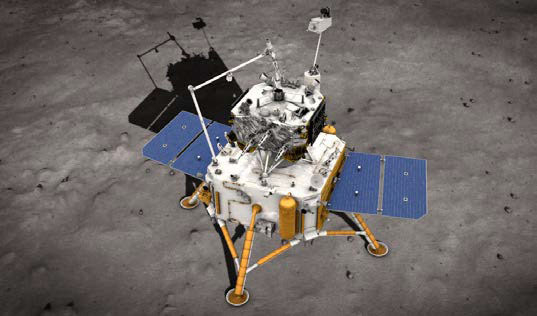China's Chang'e 5 mission: Sampling the lunar surface
China's grab-and-go mission.

The Chang'e 5 lunar mission is the Chinese National Space Administration's (CNSA) effort to send a robotic spacecraft to the moon to collect samples and return them to Earth for scientific study. It's China's first attempt at a sample-return mission, and will be the first probe to bring back material from the moon since the Soviet Union's Luna 24 mission in 1976.
Chang'e 5 is part of the CNSA's Chang'e lunar exploration program. Named for a Chinese goddess of the moon, the series of missions aims to steadily increase their technological capabilities, laying the groundwork for future human landings.
What the Chang'e 5 mission has accomplished so far
The Chang'e 5 probe launched on Nov. 23, 2020 from Wenchang Space Launch Center in Hainan province atop a Long March 5 rocket. Weighing in at 18,100 lbs. (8,200 kilograms), the spacecraft consists of four modules, two of which remained in lunar orbit.
The other two — the sample collector and an ascent vehicle — landed on the moon on Dec. 1 near a massive mountain called Mons Rümker. The mountain is situated in the Oceanus Procellarum ("Ocean of Storms"), a vast volcanic plain that has been explored by a number of other moon missions, including Apollo 12.
Related: Watch China's Chang'e 5 spacecraft land on the moon in this amazing video
Chang'e 5 is one of four active spacecraft China has on the lunar surface at the moment. The other three are the Chang'e 3 lander, which arrived in 2013, and the Chang'e 4 lander and Yutu 2 rover, which landed together on the far side of the moon in January 2019.
Within hours of landing, Chang'e 5 swiftly got to work, operating its scoop arm to collect samples from the moon's surface. The lander has successfully collected 4.4 lbs. (2 kg) of lunar material, some of which was dug from up to 6.5 feet (2 meters) underground using a drill.
The spacecraft is solar powered, so it had to get all of its work done within two Earth weeks, before the sun set on Mons Rümker. (One day on the moon lasts about 29 Earth days, so sites on the lunar surface receive two weeks of continuous sunlight followed by two weeks of darkness.)
During its time on the lunar surface, Chang'e 5 deployed a tiny Chinese flag weighing 0.4 ounces (12 grams) — the country's first fabric flag planted on the moon. Previous Chang'e missions had Chinese flags painted on the side of the spacecraft.
Related: NASA's spacecraft spot's China's Chang'e 5 lander on the moon
On Dec. 3, just two days after landing, Chang'e 5 placed its samples in the ascent vehicle, which then launched from the moon's surface back to lunar orbit. The module docked with an orbiter on Dec. 5, conducting the first fully robotic docking around the moon in history. The lunar samples were passed to a return capsule on the orbiter, which will remain in orbit for about a week before heading back to Earth.
The samples are expected to return to Earth before the end of 2020, arriving at Siziwang Banner, Inner Mongolia — the same site used by the CNSA to return astronauts home aboard its Shenzhou spacecraft.
What China hopes to learn from Chang'e 5
Rocks from the area near Mons Rümker are thought to have formed just 1.2 billion years ago, making them much younger than 3-billion-year-old samples collected by Apollo astronauts in the Oceanus Procellarum. The material could help scientists understand why this area of the moon was geologically active long after volcanism in most other parts of the moon ended.
The mission's successes will also help with developing plans to send astronauts to the moon in the future. "The rendezvous and docking, together with the preceding moves of landing and take-off… has laid a technical foundation for our future projects of deep space exploration and [crewed] lunar mission," Liu Ran, director of the CNSA's Lunar Exploration and Space Program Center told Chinese media.
Additional resources:
- Read more about the Chang'e program from the Hong Kong Science Museum.
- Watch this video about the first three phases of the Chang'e program from Beijing Review.
- Find out more about past and future Chinese lunar missions, according to NASA.
Join our Space Forums to keep talking space on the latest missions, night sky and more! And if you have a news tip, correction or comment, let us know at: community@space.com.
Get the Space.com Newsletter
Breaking space news, the latest updates on rocket launches, skywatching events and more!

Adam Mann is a journalist specializing in astronomy and physics stories. His work has appeared in the New York Times, New Yorker, Wall Street Journal, Wired, Nature, Science, and many other places. He lives in Oakland, California, where he enjoys riding his bike. Follow him on Twitter @adamspacemann or visit his website at https://www.adamspacemann.com/.










